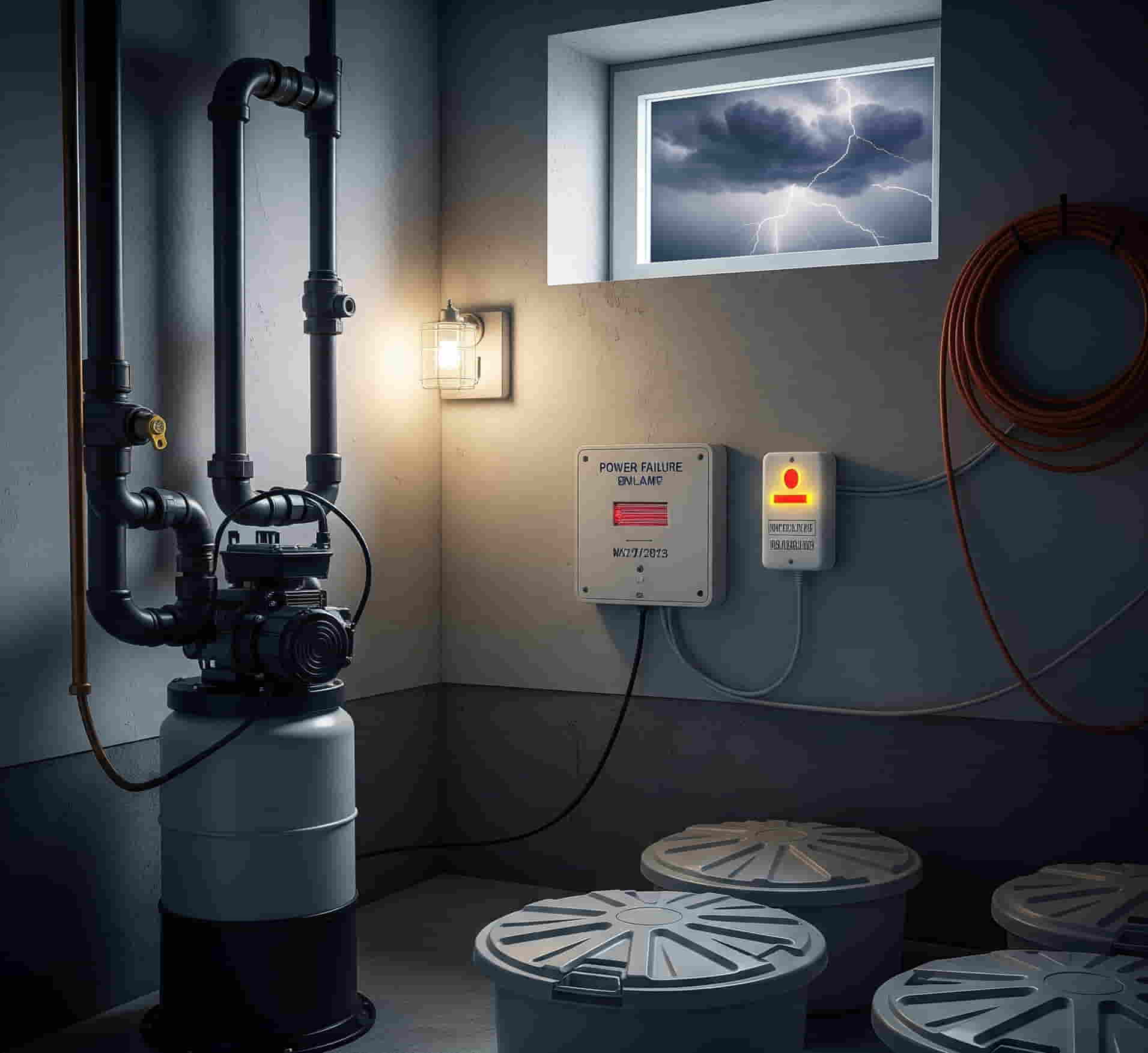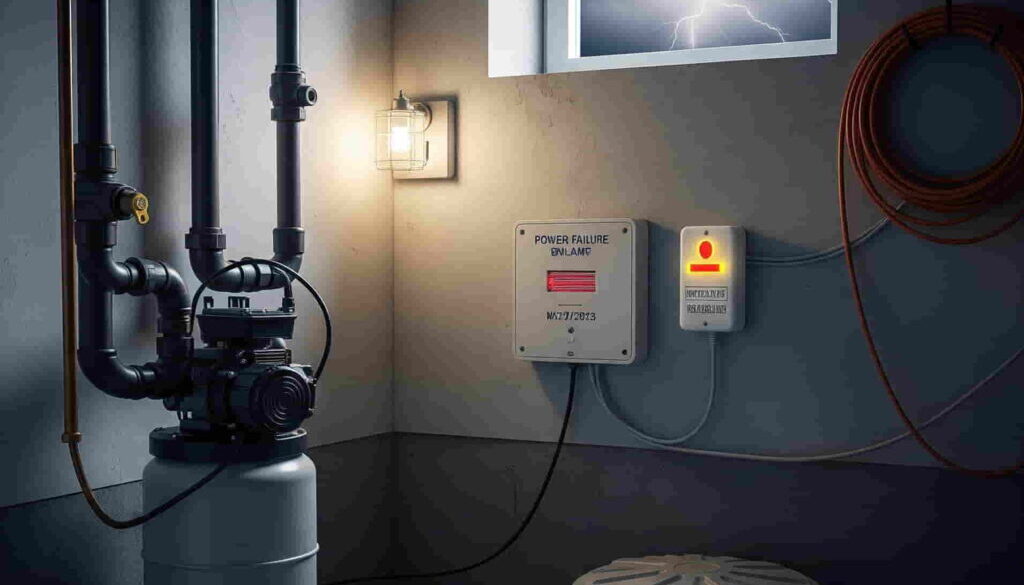How to Install a Power Failure Alarm in Your Basement (Step-by-Step Guide)
Worried your sump pump will fail during a storm?
That concern isn’t just about inconvenience—it’s about avoiding a flooded basement, costly repairs, and the stress that comes with being unprepared during a power outage. For many cautious homeowners, especially those living in areas prone to storms, this fear is tied to something very real: water damage that creeps in while the power is out and the sump pump is silent.
A power failure alarm is a small, homeowner-friendly device designed to alert you when the power goes out near your sump pump. And the good news? Installing one is surprisingly straightforward. This guide walks through the process in clear, simple steps—perfect for homeowners who are DIY-inclined but not technically trained.
What Is a Power Failure Alarm?
A power failure alarm is a compact device that detects power loss at a specific outlet—typically the one powering your sump pump—and sounds a loud alert when that happens.
Why It Matters:
- Instant Awareness: If the power goes out while you’re home, you’ll hear the alarm and know your sump pump has stopped working.
- Basement Protection: You get early warning before water starts accumulating.
- Peace of Mind: Even if you’re not home, someone nearby may hear the alarm and take action.
Many models are plug-and-play, while others include battery backups or even remote sensor options. The goal is the same: alert you when your sump pump can no longer protect your basement.
Why Homeowners Are Installing These Devices
Let’s be real—storms happen. Power outages are unpredictable. And sump pumps don’t work without electricity.
Homeowners exploring power failure alarms often share a few common concerns:
- “What if the basement floods while I’m on vacation?”
- “I wouldn’t even know the pump stopped working until it’s too late.”
- “I don’t want to rely on blind luck during storm season.”
For many, it’s not about being an expert—it’s about taking simple, effective steps to protect what matters.
What You’ll Need Before Getting Started
This process doesn’t require complex tools or advanced skills. Here’s what you’ll want to gather before you begin:
Tools & Supplies:
- Power failure alarm unit (typically $50–$150)
- Access to the outlet that powers your sump pump
- Optional: screwdriver and mounting hardware (if your alarm requires wall mounting)
- Fresh batteries (for battery-powered or backup-enabled models)
- Flashlight (just in case your basement lighting isn’t great)
Location Guidelines:
- Place the alarm as close to your sump pump as possible—ideally in the same outlet.
- Make sure the sound can travel—don’t hide the alarm behind boxes or heavy shelving.
- If possible, keep the unit visible for easy access and testing.
Step-by-Step Installation Process
Let’s walk through the entire installation, from opening the box to testing your alarm. The good news? Many homeowners complete this process in under 30 minutes.
Step 1: Unbox the Alarm and Review the Instructions
Before anything else, take a moment to familiarize yourself with your specific unit. Look for:
- Plug style (standard vs. pass-through)
- Battery compartment (and whether backup power is included)
- Sensor wire or probe (if applicable)
Some models include a quick-start guide, and that’s a great reference to keep handy throughout installation.
Step 2: Identify the Outlet Connected to Your Sump Pump
- Unplug your sump pump briefly to make room.
- Plug the alarm directly into the same outlet.
- If your alarm has a pass-through feature, plug the sump pump into the alarm.
- If it doesn’t, just plug the alarm into the other socket of the duplex outlet.
This placement is critical. You want the alarm to detect a power failure where it counts—right where the sump pump draws power.
Step 3: Install Batteries (If Required)
Some alarms run entirely on battery power. Others use batteries as a backup in case the outlet loses power.
- Insert fresh batteries (typically AA or 9V) following the unit’s instructions.
- Use quality batteries to avoid issues during critical times.
- Write the installation date on a small label and attach it to the alarm or wall nearby as a reminder for replacement intervals.
Step 4: Mount or Position the Alarm
You’ve got a couple of options depending on the model:
- Freestanding units: Place it on a nearby shelf or flat surface.
- Wall-mount models: Use screws or adhesive strips to secure it near the sump pump.
- Clip-on models: Some come with sensor wires that attach directly to cords or outlets.
Key consideration: Make sure the speaker is not obstructed. You want to hear the alarm when it goes off—even from upstairs.
Step 5: Connect the Sensor Wire (If Your Model Has One)
Some models include a small wire or clip that senses power flow.
- Attach it as instructed—usually to the plug or outlet area.
- Route the wire neatly along a wall or surface to avoid tangles or interference.
- Secure it lightly so it doesn’t come loose if bumped.
Step 6: Test the System
This step is non-negotiable.
- Simulate a power outage by unplugging the sump pump (or the alarm, if it’s in-line).
- Listen for the alarm—many emit a sound around 85–100 decibels.
- Confirm the alarm sounds within seconds.
- Plug everything back in and check that the system resets.
If it doesn’t work as expected, double-check battery placement and outlet function.
+——————————————————————————————————-+
💡 Quick Takeaways
- Simple Setup: Most alarms plug in and work immediately—perfect for DIY-minded homeowners.
- Location Matters: Place near the sump pump for accurate detection and loud alerts.
- Test Before Storm Season: Verifying functionality in advance can prevent stressful surprises.
+——————————————————————————————————-+
Maintaining Your Alarm for Long-Term Reliability
Once installed, your power failure alarm doesn’t need much attention—but it shouldn’t be forgotten, either.
Tips to Keep It Working:
- Monthly testing: Unplug to check the alarm response.
- Battery changes: Replace every 6–12 months, or as recommended by the manufacturer.
- Visual checks: Ensure it hasn’t been accidentally unplugged, blocked, or damaged.
- Label the unit: If you have multiple devices in your utility area, add a small label identifying this one as your sump alarm.
Think of it like a smoke detector—quiet when all is well, loud when something’s wrong, and only helpful if it’s working properly.
Bonus: When to Install One (and Why Timing Matters)
Many homeowners install power failure alarms just before:
- Storm seasons
- Extended travel or vacations
- Major home renovations that affect power circuits
Why? Because these are the moments when sump pump failure would be most devastating—and also when you’re least likely to notice until it’s too late.
Even if you’ve never had a flooding issue before, the alarm acts as an inexpensive insurance policy for your peace of mind.
Summary: A Small Step That Makes a Big Difference
Installing a power failure alarm is a proactive move that reflects care, caution, and a commitment to protecting your home. It doesn’t require an electrician, it doesn’t break the bank, and it directly addresses a common weak point in basement flood prevention: the unnoticed outage.
With this small but powerful addition to your sump pump setup, you’re not just reacting to emergencies—you’re preparing for them.

Frequently Asked Questions (FAQs)
Q: Do I need an electrician to install a power failure alarm?
A: No. These alarms are typically designed for homeowners and can be installed without professional assistance.
Q: Will the alarm still work if my entire basement loses power?
A: Yes, if your model includes a battery or backup battery function. Plug-in-only models won’t work during a full outage unless they include battery support.
Frequently Unasked Questions (FUQs)
Q: Where should I install the alarm to maximize alert audibility?
A: Ideally, place the alarm close to the sump pump and as far from obstructions as possible. If your basement is soundproofed or distant, consider a model with remote alerts.
Q: How often should I test or replace the alarm battery?
A: Test monthly. Replace the battery at least once a year, or immediately if you hear chirping or get a low-battery warning.


